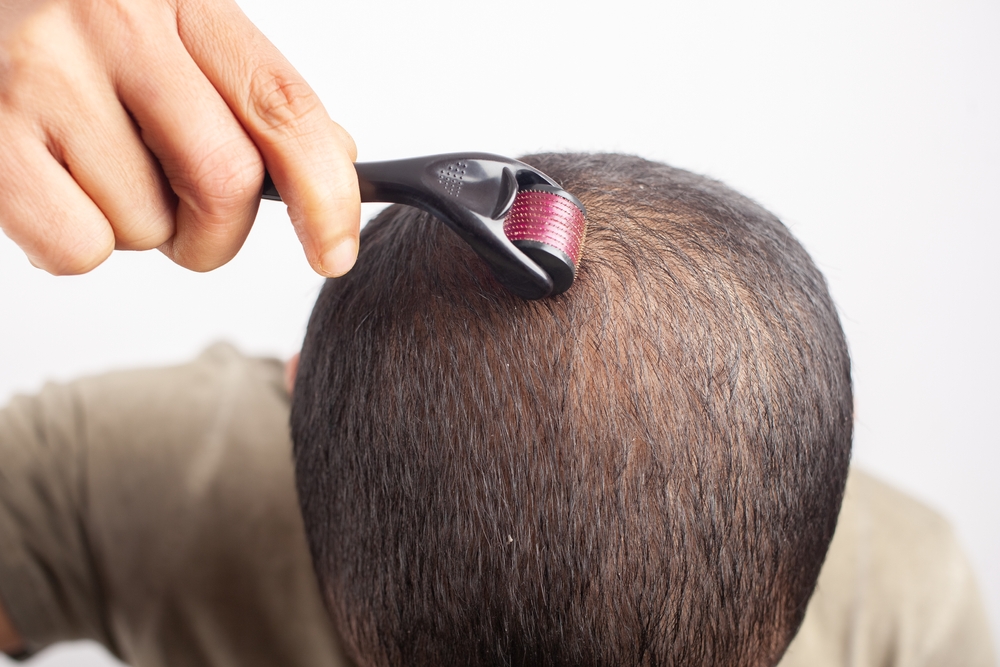A dermaroller is a handheld device that resembles a small paint roller. Attached to the roller are hundreds of titanium micro-needles that gently prick your scalp and puncture the skin as you roll the dermaroller over areas of thinning hair on your head.
The science behind dermarolling for hair loss lies in the ability of the micro-needles to stimulate the dermal layer of your skin, increase blood flow to the scalp, and generate new cell growth to encourage hair growth.
Do dermarollers work? The short answer is yes, and there’s plenty of research to back it up. Here’s the scoop on dermarolling for hair loss.
Summary
- Dermarolling for hair loss involves microneedling the scalp to stimulate hair growth.
- Microneedling has been proven to promote hair thickness and/or hair count
- Dermarolling is a safe and effective home hair loss treatment for most men and women. It works best when combined with other topical hair loss solutions like minoxidil.
Dermaroller For Hair Loss: How Does It Really Work?
The "microinjuries" caused by microneedling/derma rolling make the skin think it's experiencing an injury. Microneedling creates micropunctures in the skin but does not damage the outer layer of your skin (epidermis).
Consequently, your skin initiates a wound healing process that involves the release of proteins, growth factors, collagen production, and other chemicals that are (coincidentally) also essential for better follicle health and hair growth!
In addition to launching this healing cascade, dermaroller microneedles and tiny punctures bolster revascularization of the scalp and break down scar strands that may hinder hair growth.
Research suggests that microneedling may also increase the electrical potentials (signaling) of surrounding cells, further triggering the release of extra proteins, growth factors, and potassium.
Other cells involved in stimulating hair growth using dermarollers are stem cells. Micro-injuries affecting skin anywhere on the body triggers the production of stem cells that transform themselves into special cells designed to repair and maintain tissue health. Stem cells created from these tiny skin punctures may also contribute to enhancing follicle functioning, faster hair growth, less hair thinning, and thicker hair.

Dermarolling for Hair Loss: Multiple Studies Reveal the Benefits of Microneedling
A comprehensive summary of academic articles that investigated the ability of microneedling for hair growth found that microneedling monotherapy (microneedling by itself) significantly increased hair growth compared to using minoxidil by itself. Minoxidil is the main ingredient in Rogaine, though you can now get it as a generic (including from Shapiro MD).
However, when microneedling and minoxidil were combined, the results surpassed the hair count improvement seen in microneedling alone AND minoxidil alone. Bottom line: use a dermaroller consistently and hair grows!
The authors of this summary note that there are few studies available that evaluate microneedling alone for hair loss because most studies combine microneedling with topical hair loss agents.
Effects of Microneedling on Adults with Androgenic Alopecia
Another study researched the effects of microneedling with dermarollers using two different sizes of microneedles, or needle length. The study included 60 men and women between the ages of 18 and 45 who had moderate to severe androgenic alopecia (male or female pattern baldness). Participants were divided into three treatment groups:
- (A) Minoxidil 5% only
- (B) Biweekly microneedling (needle depth of 1.2 mm) while using minoxidil 5%
- (C) Biweekly microneedling (needle depth of 0.6 mm) while using minoxidil 5%
After 12 weeks of treatment, each group was evaluated for hair thickness and hair count. The results indicated:
- All three groups had significant increases in hair thickness and hair count
- Group B's hair thickness and hair count were significantly greater than Group A
- Group B and C's hair regrowth was significantly greater than Group A
Researchers concluded that microneedling (0.6 mm depth) combined with minoxidil was more effective in terms of hair thickness and hair count than minoxidil monotherapy.
They also concluded that a penetration depth of 1.2mm is more beneficial than 0.6 mm to stimulate hair growth.
Dermarolling Plus Minoxidil Enhances Hair Restoration vs Minoxidil Alone
Microneedling is known to facilitate the delivery of topical medications under the skin barrier. That's a key part of its benefits.
Following a dermaroller microneedling session, the scalp's microinjuries allow topicals like minoxidil to pass directly into the vessel-rich dermis. Additionally, microneedling widens the follicle tunnels, which helps accelerate the absorption of topical medications by the skin.
Other topicals for hair loss can also be used in combination with dermarollers, such as finasteride and retinoids. However, men with male pattern baldness should be aware that dermaroller microneedling does not reduce levels of dihydrotestosterone (DHT), which is mainly responsible for male pattern baldness. Combining dermarolling with solutions that fight DHT, like Shapiro MD Shampoo for hair loss may help further. Oral finasteride is another option for men.
What is the Most Effective Way to Use a Dermaroller for Hair Growth?
The most common microneedle size used for treating hair loss with dermarollers is 1.5 mm, when it is used alone. Hair follicles are generally located between 1mm and 2mm under the scalp. The 1.5 mm measurement is therefore the median for most people with normal hair follicles.
You can always use shorter needles if preferred but they may not be as effective for achieving your desired hair growth.
How to Use a Dermaroller
- Before dermarolling your scalp, brush targeted areas with a brush and shampoo to help exfoliate dead skin and debris. Thoroughly rinse the shampoo from your hair and comb out tangles until your hair is flat and tangle-free.
- Wash the dermaroller (including needles) with soap and water. Use rubbing alcohol to sanitize the roller each time you use it.
- Part your hair to allow the dermaroller to make contact with the scalp. Repeat parting of your hair and dermarolling parted sections until you have reached all scalp areas with the dermaroller. Roll the dermaroller horizontally over exposed parts of the scalp.
- Roll targeted areas at least eight times for maximum stimulation of the skin.
- Try dermarolling daily for 10 minutes or so.
When used as directed, dermarollers can provide visible results in as little as two to three months. Compared to topical hair loss products that must be used consistently for six months to see noticeable hair growth, dermarollers may provide considerably faster results.
However, if you don't see results in three months, don't stop dermarolling! Some people simply take longer to notice improved hair growth based on their genetics, health, and other factors.
Better yet, combine dermarolling with minoxidil for even better outcomes.
Side effects from dermaroller microneedling are minimal and typically disappear as the scalp begins the healing process. The most common side effects include minor swelling, slight pain, and/or redness or bruising of treated areas. People with sensitive scalps may experience more discomfort during the first couple of weeks of using a dermaroller.
To help reduce irritation, wear a hat or apply sunscreen to exposed areas of your scalp if you expect to be outdoors in sunlight. Avoid using dandruff shampoos while using a dermaroller or shampoos meant to treat moderate to severe scalp problems (eczema, ringworm, psoriasis).
Those who have a history of acne or eczema, or take blood thinners, should consult with their doctor before using a dermaroller. In addition, some health conditions interfere with the healing process, such as diabetes or immunosuppressive disorders. If you have such a disease, always ask your doctor about using a dermaroller for hair loss. The microinjuries caused by dermarolling may not heal properly if the immune system is not functioning normally.
You don't need a specialist to get started with a derma roller at home.
The dermatologists behind Shapiro MD have made the most effective topical and oral hair loss treatments even easier to get than ever.
Click here to see the full lineup and start your hair regrowth journey today.
References
https://www.ncbi.nlm.nih.gov/pmc/articles/PMC4976400/
https://www.ncbi.nlm.nih.gov/pmc/articles/PMC5797699/
https://www.ncbi.nlm.nih.gov/pmc/articles/PMC4458936/




